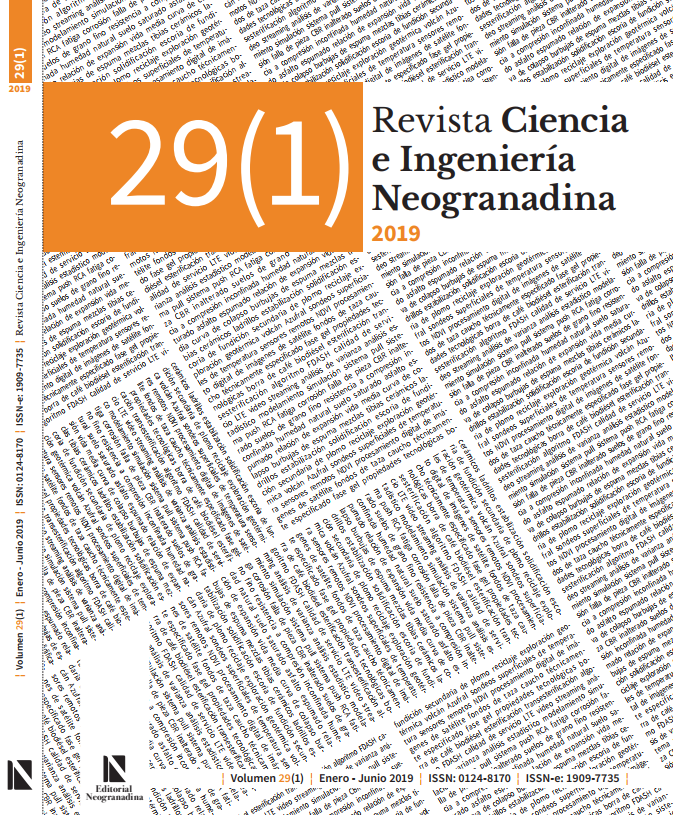Correlación del CBR con la resistencia a la compresión inconfnada
Resumen
Los espesores y propiedades de las capas de una estructura de pavimento son altamente
determinados por la rigidez de la subrasante. En algunos casos, no es posible la ejecución de pruebas directas para determinar dicha rigidez, al menos en la frecuencia requerida, y es necesario usar
correlaciones con otras propiedades del suelo. Este artículo presenta resultados de un programa
experimental realizado para obtener correlaciones entre el CBR (por sus siglas en inglés) inalterado
de suelos fnos con su resistencia a la compresión inconfnada o algunas propiedades índice. Se realizaron ensayos de CBR de laboratorio, resistencia a la compresión inconfnada, límites de Atterberg,
granulometría y humedad natural. El número de muestras (38) fue seleccionado para garantizar seguridad y poder estadístico del 95 % y un coefciente de correlación de Pearson (r) mínimo de 0,60.
Aunque no fue posible correlacionar el CBR con las propiedades índice evaluadas, se obtuvieron
correlaciones entre el CBR natural y saturado, y la resistencia a la compresión inconfnada. Las correlaciones obtenidas, que tuvieron valores r > 0,80, fueron comparadas con algunas correlaciones en la
literatura entre el CBR y otros ensayos de resistencia no drenada. Para la misma resistencia, los CBR
en este estudio son considerablemente menores que los de dichas correlaciones.
Descargas
Referencias bibliográficas
S. H. Carpenter, M. R. Crovetti, K. L. Smith, E. Rmeili y T. Wilson. Soil and base stabilization and associated drainage considerations. Washington D.C., United States: U.S. Department of Transportation Federal Highway Administration, Office of Technology Applications, Publication No FHWA-SA-93-004, 1992, 160 p.
Indiana Department of Transportation. Design procedures for soil modification or stabilization. West Lafayette, United States: Division of Engineering and Asset Management Office of Geotechnical Services, Indiana Department of Transportation, 2015, 18 p.
A. El Howayek, D. Muschett, T. Nantung, J. Lee, M. Santagata y A. Bobet. Verification of the enhanced integrated climatic module soil subgrade input parameters in the MEPDG. West Lafayette, United States, Purdue University: Joint Transportation Research Program Publication No. FHWA/IN/JTRP-2016/08, 2016, 16 p.
DOI: http://dx.doi.org/10.5703/1288284316331
American Association of State Highway and Transportation Officials. AASHTO Guide for Design of Pavement Structures. Washington, D.C. United States, 1993, 624 p.
C. Jung y A. Bobet. Post-construction evaluation of lime-treated soils. West Lafayette, United States, Purdue University: Joint Transportation Research Program Publication No. FHWA/IN/JTRP-2007/25, 2008, 247 p.
DOI: http://dx.doi.org/10.5703/1288284313443
H. A. Rondón Quintana y F. A. Reyes Lizcano, “Metodologías de diseño de pavimentos flexibles: tendencias, alcances y limitaciones,” Ciencia e Ingeniería Neogranadina, Vol.17, no. 2, pp. 41-65, 2007.
DOI: http://dx.doi.org/10.15446/dyna.v81n183.36981
American Association of State Highway and Transportation Officials. Mechanistic-empirical pavement design guide, A Manual of Practice. Washington, D.C. United States, 2008, 205 p.
G. H. Gregory y S. A. Cross, “Correlation of CBR with Shear-Strength Parameters,” en Proceedings of 9th Int. Conf. on Low-Volume Roads, 2007, pp. 1-14.
B. R. Christopher, C. Schwartz y R. Boudreau. Geotechnical aspects of pavements. Washington D.C., United States: U.S. Department of Transportation, Federal Highway Administration, Report No. NHI-05-037, 2006, 888 p.
Minitab 17 Statistical Software. [Computer software], Minitab, Inc. State College, United States, 2010: (https://www.minitab.com).
ASTM D1883 – 05. Standard Test Method for CBR (California Bearing Ratio) of Laboratory-Compacted Soils. ASTM International, 2005.
ASTM D2166 – 00. Standard Test Method for Unconfined Compressive Strength of Cohesive Soil. ASTM International, 2000.
ASTM D4318 – 10. Standard Test Method for Liquid Limit, Plastic Limit, and Plasticity Index of Soils. ASTM International, 2010.
ASTM D46913 – 09. Standard Test Method for Particle-Size Distribution (Gradation) of Soils Using Sieve Analysis. ASTM International, 2009.
ASTM D2216 – 10. Standard Test Method for Laboratory Determination of Water (Moisture) Content of Soil and Rock by Mass. ASTM International, 2010.
D. C. Montgomery, E. A. Peck y G. G. Vining. Introduction to Linear Regression Analysis. New York, United States: John Wiley & Sons, 2003, 645 p.
W. P. M. Black, “A method of estimating the California bearing ratio of cohesive soils from plasticity data,” Géotechnique, Vol.12, no. 4, pp. 271-282, 1962. DOI: https://doi.org/10.1680/geot.1962.12.4.271
N. B. Shirur y S. G. Hiremath, “Establishing relationships between CBR value and physical properties of soil,” IOSR Journal of Mechanical and Civil Engineering, Vol.11, no. 5, pp. 26-30, 2014.
W. P. M. Black, “The calculation of laboratory and in-situ values of California bearing ratio from bearing capacity data,” Géotechnique, Vol.11, no. 1, pp. 14-21, 1961. DOI: https://doi.org/10.1680/geot.1961.11.1.14
W. P. M. Black y N. W. Lister. The strength of clay fill subgrades: its prediction in relation to road performance. Crowthorne, Berkshire, UK: TRRL Laboratory Report 889, Transport and Road Research Laboratory, 1979, 30 p.
A. W. Skempton, “The Bearing Capacity of Clays,” en Proceedings of Building Research Congress, 1951, pp. 180-190.
W. P. M. Black. The strength of clay fill subgrades: its measurement by a penetrometer. Crowthorne, Berkshire, UK: TRRL Laboratory Report 901, Transport and Road Research Laboratory, 1979, 13 p.











